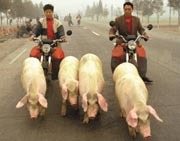Abstract
Health authorities in the dark as warnings go untranslated
Tokyo
Potentially alarming findings on the avian influenza epidemic currently sweeping southeast Asia went largely unnoticed because they were published in Chinese-language journals, it emerged last week.

Rotten swine: pigs could host viruses, brewing a human pandemic.
AP/XINHUA
Chinese researchers reported this January that the strain of the bird flu virus involved, known as H5N1, had infected pigs. This is a cause for concern, as some virologists believe that previous human flu pandemics, such as the one in 1918 that killed millions, originated in pigs. Yet neither the World Health Organization (WHO) nor the UN Food and Agriculture Organization (FAO) was aware of the results when they were published. Last week both groups were hurriedly trying to get the papers translated.
The findings became widely known only when an author on the papers, virologist Chen Hualan of Harbin Veterinary Research Institute in northeast China, presented them at the International Symposium on the Prevention and Control of SARS and Avian Influenza in Beijing on 20 August. The results, which show that the virus was found in 2003 in pigs in southeast China, were originally published in January (L. I. Haiyan et al. Chin. J. Prev. Vet. Med. 26, 1–6; 2004). A second paper by Chen and her colleagues appeared in May, reporting similar results from pigs tested elsewhere in 2001 and 2003 (L. I. Haiyan et al. Chin. J. Vet. Sci. 24, 304–309; 2004).
The H5N1 strain, which can be fatal to humans, does not jump easily from birds to humans or between humans. But this might change if pigs are infected, says Malik Peiris, a virologist at teh University of Hong Kong . The virus could exchange genes with the human flu strains that infect pigs and combine to become far more infectious to humans, he warns. Peiris's group has already shown that a human virus, H3N2, can coexist with other avian influenza viruses and is widespread in pigs from southeast China. Pigs are an “ideal mixing vessel”, he says. “It is certainly sufficient to make me concerned.”
The H5N1 virus has spread through most of southeast Asia this year, resulting in the destruction of over 100 million chickens, including 9 million in China. In Vietnam and Thailand, 37 human infections have been reported, with 26 deaths.
The abstract to Chen's January article ends with the warning that “urgent attention should be paid to the pandemic preparedness of these two subtypes of influenza”. But the results attracted no attention outside China before last week. The WHO and the FAO are now waiting to see a translation of the article and to hear from the Chinese agriculture ministry before deciding what steps to take. Until then, they urge caution and say that the significance of the findings cannot yet be judged.
The ministry, which seemed to be surprised by the disclosure, moved to calm fears after the news broke. A ministry press release, issued on 23 August, stated that tests on “over 1.1 million samples of poultry and some samples of pigs” conducted this year showed no evidence of H5N1. Officials add that routine testing by Hong Kong researchers of imported pigs had also not turned up evidence of H5N1.
Related links
Related links in Nature Research
10.1038/nature02746
10.1038/430822a
10.1038/427472a


